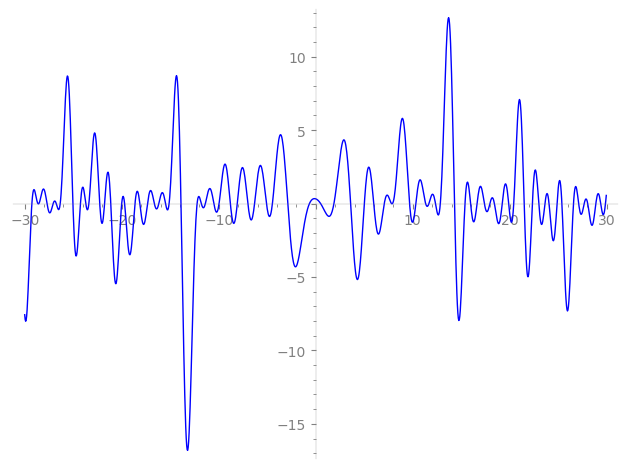| L(s) = 1 | + (−1.39 + 0.247i)2-s + (−2.44 + 1.41i)3-s + (1.87 − 0.688i)4-s − 2.72·5-s + (3.05 − 2.56i)6-s + (0.866 + 0.5i)7-s + (−2.44 + 1.42i)8-s + (2.48 − 4.30i)9-s + (3.79 − 0.673i)10-s + (−1.16 − 2.02i)11-s + (−3.61 + 4.33i)12-s + (−2.95 + 2.06i)13-s + (−1.32 − 0.482i)14-s + (6.65 − 3.84i)15-s + (3.05 − 2.58i)16-s + (−0.404 + 0.700i)17-s + ⋯ |
| L(s) = 1 | + (−0.984 + 0.174i)2-s + (−1.41 + 0.814i)3-s + (0.938 − 0.344i)4-s − 1.21·5-s + (1.24 − 1.04i)6-s + (0.327 + 0.188i)7-s + (−0.864 + 0.503i)8-s + (0.827 − 1.43i)9-s + (1.19 − 0.212i)10-s + (−0.352 − 0.610i)11-s + (−1.04 + 1.25i)12-s + (−0.819 + 0.572i)13-s + (−0.355 − 0.128i)14-s + (1.71 − 0.992i)15-s + (0.763 − 0.646i)16-s + (−0.0981 + 0.169i)17-s + ⋯ |
\[\begin{aligned}\Lambda(s)=\mathstrut & 728 ^{s/2} \, \Gamma_{\C}(s) \, L(s)\cr =\mathstrut & (0.431 - 0.901i)\, \overline{\Lambda}(2-s) \end{aligned}\]
\[\begin{aligned}\Lambda(s)=\mathstrut & 728 ^{s/2} \, \Gamma_{\C}(s+1/2) \, L(s)\cr =\mathstrut & (0.431 - 0.901i)\, \overline{\Lambda}(1-s) \end{aligned}\]
Particular Values
| \(L(1)\) |
\(\approx\) |
\(0.268641 + 0.169212i\) |
| \(L(\frac12)\) |
\(\approx\) |
\(0.268641 + 0.169212i\) |
| \(L(\frac{3}{2})\) |
|
not available |
| \(L(1)\) |
|
not available |
\(L(s) = \displaystyle \prod_{p} F_p(p^{-s})^{-1} \)
| $p$ | $F_p(T)$ |
|---|
| bad | 2 | \( 1 + (1.39 - 0.247i)T \) |
| 7 | \( 1 + (-0.866 - 0.5i)T \) |
| 13 | \( 1 + (2.95 - 2.06i)T \) |
| good | 3 | \( 1 + (2.44 - 1.41i)T + (1.5 - 2.59i)T^{2} \) |
| 5 | \( 1 + 2.72T + 5T^{2} \) |
| 11 | \( 1 + (1.16 + 2.02i)T + (-5.5 + 9.52i)T^{2} \) |
| 17 | \( 1 + (0.404 - 0.700i)T + (-8.5 - 14.7i)T^{2} \) |
| 19 | \( 1 + (-3.64 + 6.31i)T + (-9.5 - 16.4i)T^{2} \) |
| 23 | \( 1 + (3.78 + 6.56i)T + (-11.5 + 19.9i)T^{2} \) |
| 29 | \( 1 + (-7.22 + 4.17i)T + (14.5 - 25.1i)T^{2} \) |
| 31 | \( 1 - 8.04iT - 31T^{2} \) |
| 37 | \( 1 + (-5.38 - 9.31i)T + (-18.5 + 32.0i)T^{2} \) |
| 41 | \( 1 + (5.23 - 3.02i)T + (20.5 - 35.5i)T^{2} \) |
| 43 | \( 1 + (5.20 + 3.00i)T + (21.5 + 37.2i)T^{2} \) |
| 47 | \( 1 + 4.39iT - 47T^{2} \) |
| 53 | \( 1 - 7.53iT - 53T^{2} \) |
| 59 | \( 1 + (6.75 - 11.7i)T + (-29.5 - 51.0i)T^{2} \) |
| 61 | \( 1 + (-5.93 - 3.42i)T + (30.5 + 52.8i)T^{2} \) |
| 67 | \( 1 + (0.420 + 0.728i)T + (-33.5 + 58.0i)T^{2} \) |
| 71 | \( 1 + (-7.83 - 4.52i)T + (35.5 + 61.4i)T^{2} \) |
| 73 | \( 1 + 3.38iT - 73T^{2} \) |
| 79 | \( 1 - 0.508T + 79T^{2} \) |
| 83 | \( 1 - 6.29T + 83T^{2} \) |
| 89 | \( 1 + (8.54 - 4.93i)T + (44.5 - 77.0i)T^{2} \) |
| 97 | \( 1 + (-3.19 - 1.84i)T + (48.5 + 84.0i)T^{2} \) |
| show more | |
| show less | |
\(L(s) = \displaystyle\prod_p \ \prod_{j=1}^{2} (1 - \alpha_{j,p}\, p^{-s})^{-1}\)
Imaginary part of the first few zeros on the critical line
−10.49916171134300351231478781154, −9.963644509301948023895190336243, −8.799928165973736385880429314783, −8.084982765196052861614225058433, −6.99474116942065478244280467495, −6.30375564351036733789147795710, −5.07867496848168922558362478967, −4.46432243107122798796276963261, −2.88216299181792751030151049999, −0.64565136719046630023330538490,
0.50201083433925145108460973248, 1.87741955649579793698530370002, 3.59728491964024703608222813554, 5.01212670233183621895473214840, 5.97871520781977659899003098710, 7.06539693996799702726372835057, 7.80886133603643096432141940096, 7.913234321801716677716926090177, 9.672166271600717723953867481961, 10.32078811788622034709942911297

